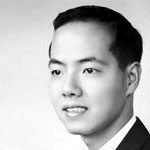
Biografia estratta da Nobel Lectures, Physics 1957.
![]() 1957 Premio Nobel per la Fisica
1957 Premio Nobel per la Fisica
(1926- vivente) Tsung-Dao Lee was born on November 24, 1926, in Shanghai, China, as the third of six children of Tsing Kong Lee, a business man, and Ming Chang Chang. He was educated at the Kiangsi Middle School in Kanchow, Kiangsi, from which he graduated in 1943. He did his matriculation at the National Chekiang University in Kweichow province. The Japanese invasion forced him to flee to Kunming, Yunnan; here he attended the National Southwest University where he met Chen Ning Yang, who in 1957 was to share the Nobel Prize with him. Being a most promising student in physics he was, in 1946, awarded a Chinese Government Scholarship, which took him to the University of Chicago, where he gained his Ph. D. degree in 1950 on his thesis Hydrogen Content of White Dwarf Stars. For some months in 1950 he served as research associate at Yerkes Astronomical Observatory, Lake Geneva, Wisconsin.
From 1950 to 1951 Dr. Lee was a research associate and lecturer at the University of California in Berkeley, and then accepted a fellowship at the Institute of Advanced Study at Princeton, N. J. Here he was a member of the Institute's Staff, from 1951 to 1953, and had occasion to work jointly with his friend Dr. Yang. Lee was then fast becoming a widely known scientist, especially for his work in statistical mechanics and in nuclear and subnuclear physics, having solved some problems of long standing and of great complexity. Dr. J. Robert Oppenheimer praised him as one of the most brilliant theoretical physicists then known, whose work was characterized by "a remarkable freshness, versatility, and style". Apart from the subject of parity non-conservation-which earned him the Nobel Prize -and statistical mechanics and nuclear physics mentioned earlier, his investigations also comprised field theory, astrophysics, and turbulence.
Lee was in 1953 appointed Assistant Professor of Physics at Columbia University, and afterwards successively promoted to Associate Professor (1955) and Professor (1956). He was then, at the age of 29, the youngest professor in the Faculty; the next year, being recipient of the Nobel Award at barely 31 years of age, he became the second youngest scientist ever to receive this distinction. (The youngest was Sir Lawrence Bragg who shared the Physics Prize with his father in 1915, at the age of twenty-five.) Together with Dr. Yang, Lee wrote several prominent articles in The Physical Review. Among the honours bestowed on Professor Lee are: the Albert Einstein Commemorative Award in Science of Yeshiva University, New York (1957) and the Science Award of the Newspaper Guild of New York.
He has also been elected Fellow of the American Physical Society and the Academia Sinica, and was awarded a D.Sc. degree by Princeton University (1958 ). Lee married (Jeannette) Hui Chung Chin a former university student, in 1950. His favourite pastimes are: playing with his two young boys, James and Stephen; and reading "whodunits" (detective novels).

